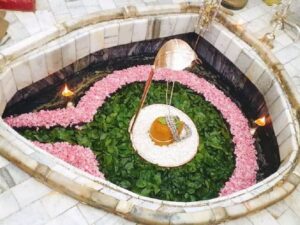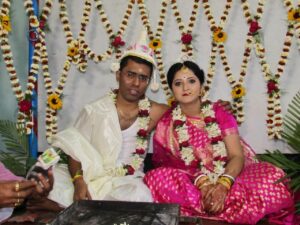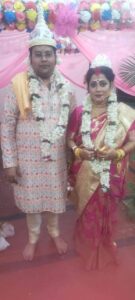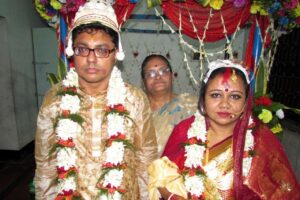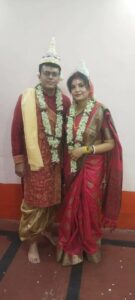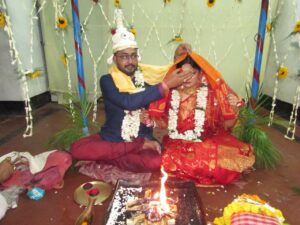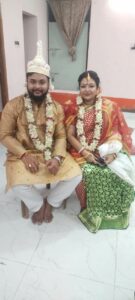Marriage in Kalighat Kali Temple—Kalighat is a locality situated in South Kolkata, India Kalighat is also densely populated and vibrant—with a rich history of cultural intermingling with the various foreign incursions into the area over time.The World famous Kalighat Kali Temple dedicated to the Goddess Kali is situated in Kalighat and is regarded as one of the 51 Shakti Peeth of India, where the various parts of Sati’s body are said to have fallen, in the course of Shiva’s Rudra Tandava. Kalighat represents the site where the toes of the right foot of Dakshayani or Sati fell. Legend has it that a devotee discovered a luminant ray of light coming from the Bhāgirathi river bed, and upon investigating its source came upon a piece of stone carved in the form of a human toe. He also found a Svayambhu Lingam of Nakuleshwar Bhairav nearby and started worshiping Kali in the midst of a thick jungle.The Shakti here is known as Kalika, while the Bhairav is Nakulesh.It is a very famous place and a pilgrimage for Shakta (Shiva and Durga/Kali/Shakti worshippers) followers within the Hindu religion. The temple is visited by pilgrims from all over India irrespective of sectarian differences. The thousands of pilgrims who flock daily to the Kalighat temple treat Kali very much like a human mother, bringing her their domestic problems and prayers for prosperity, and returning when their prayers are fulfilled to express their gratitude. Their attitude towards the Goddess is guided by their religious traditions and training, their spiritual and intellectual capacities, and the guidance of their temple priests.In Kalighat The Goddess Kali Murti is incomplete. Only the face of the Goddess Kali was made first. The hands, made of gold and silver, the tongue, the Shiva Murti and all the jewellery were added over the years.On Snan Yatra day,while giving the divine Mother the ceremonial bath, the priests tie their eyes with cloth coverings. On auspicious occasions like Kali Puja, Durga Puja, Poilabaisakh the Bengali New Year day and Sankranti large number of devotees throng the place with offerings
Sosthi Tala—This is a rectangular altar about three feet high bearing a small cactus plant. Beneath the tree, on an altar three stones are placed side by side – left to right representing the Goddesses “Sosthi”, “Sitola”, and “Mongol Chandi”. This sacred spot is known as Sosthi Tala or Monosha Tala. This altar was constructed by Gobinda Das Mondal in 1880. The place of the altar is the Samadhi of Brahmananda Giri. Here all the priests are female. No daily worship or offering of Bhog (food offering) is done here. The Goddesses here are considered as part of Maa Kali.
Natmondir-– A large rectangular covered platform called Natmondir has been erected adjacent to the main temple,from where the face of the Ma Kali can be seen. This was originally built by Zamindar Kasinath Roy in 1835. It has been subsequently renovated often.
Jor-bangla—- The spacious varandah of the main temple Facing the Makali is known as Jor Bangla. Rituals occurring inside the sanctum sanctorum are visible from the Natmondir through the Jor-bangla.
Harkath Tala—-This is the spot adjacent to the Natmondir, southwards meant for Bali (sacrifice). There are two Sacrificial altars for animal sacrifices side by side. These are known as Hari- Kath.
The bigger one is for buffalo sacrifices and the smaller one for goats and sheep. The animals are sacrificed with a single stroke of the scimitar and there is very little cruelty to animals when compared to the professional abattoirs.
Radha-Krishna Temple—This temple is known as Shamo-ray temple and is situated inside the temple at the west side of the main temple.There is a separate kitchen for preparation of vegetarian Bhog (food offering) for Radha-Krishna.
Kundupukur—This is the sacred tank situated in the south-east of the temple outside the boundary walls. Present area of the tank is approximately 10 cottahs. In the past it was bigger and called ‘Kaku-Kunda’. In 16th century ‘Sati-Ango’ ( the right toe of Sati) was discovered from this tank.This tank is well known for its power to bestow the boon of a child. The water from this tank is regarded as sacred as that of the Ganges. Efforts at draining the water from the tank for cleaning has failed in the past showing the possibility of a subterranean with Adi Ganga.
Nakhuleshwar Mahadev Temple—-This Siva temple is dedicated to the consort of Maa Kali. It is situated in Haldar Para lane on the opposite side of the temple behind the police station. This temple is also very old and mentioned in the history.
Marriage In Kalighat Kali Temple—Kalighat Kali Temple is also a holy place for marriage.Lots of couples starts their new life in front of Maa Kali with her blessing.The Pandas of Kalighat Temple helps the couples to follow the Hindu marriage rituals and all other formalities. Usually every Newly Married couples like to visit Kalighat Temple for blessing of Maa Kali and make their upcoming life happy and prosperous. And you will be happy to know that we are the only professional Wedding Planner in Kolkata for arranging Temple Marriage In Kolkata. If you are planning for a hassle free temple marriage with full privacy then you can contact us without any hesitation . In last fifteen years we have conducted more than few thousands temple marriages at Kalighat Kali Temple . All the couples are spending their life happily . We do arrange little bit decoration also on demand . Still and Video Photography, Bridal Makeup and Catering Service are also there . For Marriage at Kalighat Kali Temple Contact or Whats App Shahenai Wedding Planner 9831204764


